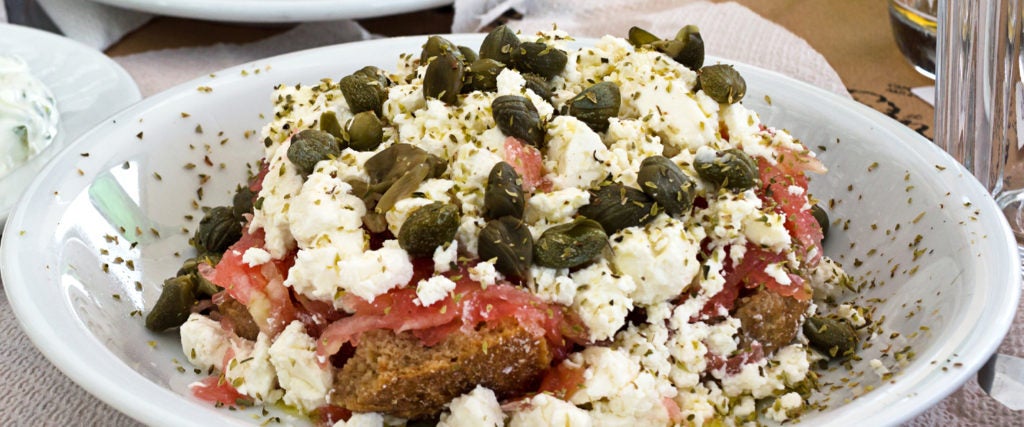On the beautiful Greek island of Santorini, in the main thoroughfare of the village of Oia, sits a small, almost incomprehensibly charming bookstore called Atlantis Books. It’s the sort of place that’s tiny and cramped because it’s so full of books, from floor to ceiling, whose variety is so large and eclectic it almost beggars belief. One of these books is Atlantis Cooks, a small, personal recipe collection from the store’s owners, one of which is the greatest, easiest and most delicious salad I’ve ever had: Dakos.
If you’re one of those people who get incredibly annoyed by people writing giant diary entries before every recipe they post online, well, so am I. Let me just say my wife and I were lucky enough to find the shop and the cookbook during a vacation in 2018, and now we eat Dakos a lot. End of story. Here are the ingredients:
- Two tomatoes
- Two green apples
- Half a cucumber
- Three slices of bread
- Feta cheese
- Olive oil, pepper and oregano
Here are the instructions:
Tear up the bread, put it in a bowl, pour olive oil on it, then add pepper and oregano. Mix this up and leave it for five minutes while the bread soaks up the oil. Chop up the tomatoes, apples and cucumbers, then mix them. Add the bread and the feta and mix again. Then eat it.
These instructions, which are close to verbatim from the cookbook, are less than 60 words long, and the salad itself can be made in less than 10 minutes. If it sounds too simple to be delicious, let me correct you immediately: Dakos is simple in its perfection, and perfect in its simplicity. It’s a phenomenal blend of different flavors that come together to make a dish far, far more delicious than the sum of its parts.
The tomatoes are tart but a little sweet, while the apples are sweet with a little tartness. The cucumber is faintly cool and moist, which matches the sour saltiness of the feta. The oil-soaked bread adds a smooth richness that binds it all together. All these flavors perfectly balance with each other, making it a thoroughly satisfying lead-in to dinner, but I am perfectly happy — happier, actually — making it for dinner, period. To be fair, though, I do make a few tweaks when assembling it.
For example, I can never find a supermarket tomato crisp enough to use for any recipe without falling apart, so I use cherry or grape tomatoes in my Dakos instead. Instead of tearing apart slices of bread, I buy a decent French loaf or boule and dice it, then I toast the pieces after tossing them in the olive oil (but only for seven or so minutes at 375 degrees — just enough to make them slightly crisp on the outside, but still soft on the inside; I don’t want croutons in my Dakos, because the cucumber and apples provide all the crunch the salad needs, in my opinion).
Also, I try to make sure the cucumbers, apple and bread slices are basically of equal size, or at least equal mass, and a little bit bigger than the tomatoes, which pack more flavor in a smaller package. I’m trying to make sure all the flavors sync, but I’m also trying to make sure there’s an equal amount of all three in the salad, all to maximize the perfect balance of flavors. This way, you can practically mix and match the parts — a tomato and chunk of bread, a cucumber and apple slice, cucumber and tomato, apple and bread, etc. And they’re all good!
Those are just my tweaks, but there are countless variations of Dakos you can find online because it’s the perfect bass riff that your culinary rock band can jam to. Even the bookstore’s version is technically a variation on the most traditional version of Dakos, which comes from the island of Crete. It uses rusks, or twice-baked bread made out of barley, as a figurative and literal base. The rusks are generally cut into slices upon which the other ingredients are placed, but being twice-baked the bread is so hard — think about it as one giant crouton — that it has to be briefly dipped in water as well as olive oil to soften it up. Since traditional Dakos is primarily a pile of tomatoes and herbs on bread, it’s often called “Greek bruschetta.” However, some break the rusk into pieces to make more traditional salad croutons (again, I maintain cutting up fresh bread and lightly toasting it is a lot easier to make and easier on your teeth).
While using rusks may be more authentic, there’s still a horde of Dakos variations. Some people forego the apples but many think black olives are a required ingredient. There are more than a few recipes that add capers or red onions as well as other fresh herbs like basil, thyme, parsley and mint. The Atlantis Books co-founders say they add peppers sometimes. A lot of recipes use creamier mizithra cheese instead of feta, although it’s harder to find in the U.S. If you want to make things more pretentious, celebrity chef Bobby Flay uses English cucumbers, beefsteak tomatoes, lemon juice, dill and chili oil. Some even grate the cucumber, tomato and/or the apple, which probably makes a bit more sense if you’re using the barley rusks to keep the topping on the bread, but I personally think that this makes the flavors amalgamate instead of pop.
So I’m perfectly content with my mild alterations to the recipe above, but part of what makes Dakos so great is its versatility: You can dump a pile of baby spinach or arugula in there if you want to turn it into a more traditional salad or add other veggies to bulk it up. If you’re an American who has a hard time imagining a meal without protein in it, I often add sauteed chicken to my Dakos, although I think pork marinated in olive oil and lemon juice (which is basically non-skewered Greek souvlaki) is a winner as well.
I’m sure some of these choices, including my own, are blasphemous to Greek food purists (and probably some native Greeks as well) but I’m okay with that. Dakos is nothing if not accommodating because it’s so simple. It doesn’t need anything to be utterly delicious beyond tossing five ingredients in a bowl with some olive oil and then maybe adding a spice or two. Give it a shot, and then tailor the recipe to your liking — you won’t be disappointed.

